Some Quick Gaming Numbers at 4K, Max Settings
by Ian Cutress on July 1, 2013 8:00 AM ESTPart of my extra-curricular testing post Computex this year put me in the hands of a Sharp 4K30 monitor for three days and with a variety of AMD and NVIDIA GPUs on an overclocked Haswell system. With my test-bed SSD at hand and limited time, I was able to test my normal motherboard gaming benchmark suite at this crazy resolution (3840x2160) for several GPU combinations. Many thanks to GIGABYTE for this brief but eye-opening opportunity.
The test setup is as follows:
Intel Core i7-4770K @ 4.2 GHz, High Performance Mode
Corsair Vengeance Pro 2x8GB DDR3-2800 11-14-14
GIGABYTE Z87X-OC Force (PLX 8747 enabled)
2x GIGABYTE 1200W PSU
Windows 7 64-bit SP1
Drivers: GeForce 320.18 WHQL / Catalyst 13.6 Beta
GPUs:
| NVIDIA | ||||||
|---|---|---|---|---|---|---|
| GPU | Model | Cores / SPs | MHz | Memory Size | MHz | Memory Bus |
| GTX Titan | GV-NTITAN-6GD-B | 2688 | 837 | 6 GB | 1500 | 384-bit |
| GTX 690 | GV-N690D5-4GD-B | 2x1536 | 915 | 2 x 2GB | 1500 | 2x256-bit |
| GTX 680 | GV-N680D5-2GD-B | 1536 | 1006 | 2 GB | 1500 | 256-bit |
| GTX 660 Ti | GV-N66TOC-2GD | 1344 | 1032 | 2 GB | 1500 | 192-bit |
| AMD | ||||||
| GPU | Model | Cores / SPs | MHz | Memory Size | MHz | Memory Bus |
| HD 7990 | GV-R799D5-6GD-B | 2x2048 | 950 | 2 x 3GB | 1500 | 2x384-bit |
| HD 7950 | GV-R795WF3-3GD | 1792 | 900 | 3GB | 1250 | 384-bit |
| HD 7790 | GV-R779OC-2GD | 896 | 1075 | 2GB | 1500 | 128-bit |
For some of these GPUs we had several of the same model at hand to test. As a result, we tested from one GTX Titan to four, 1x GTX 690, 1x and 2x GTX 680, 1x 660Ti, 1x 7990, 1x and 3x 7950, and 1x 7790. There were several more groups of GPUs available, but alas we did not have time. Also for the time being we are not doing any GPU analysis on many multi-AMD setups, which we know can have issues – as I have not got to grips with FCAT personally I thought it would be more beneficial to run numbers over learning new testing procedures.
Games:
As I only had my motherboard gaming tests available and little time to download fresh ones (you would be surprised at how slow in general Taiwan internet can be, especially during working hours), we have a standard array of Metro 2033, Dirt 3 and Sleeping Dogs. Each one was run at 3840x2160 and maximum settings in our standard Gaming CPU procedures (maximum settings as the benchmark GUI allows).
Metro 2033, Max Settings, 3840x2160:
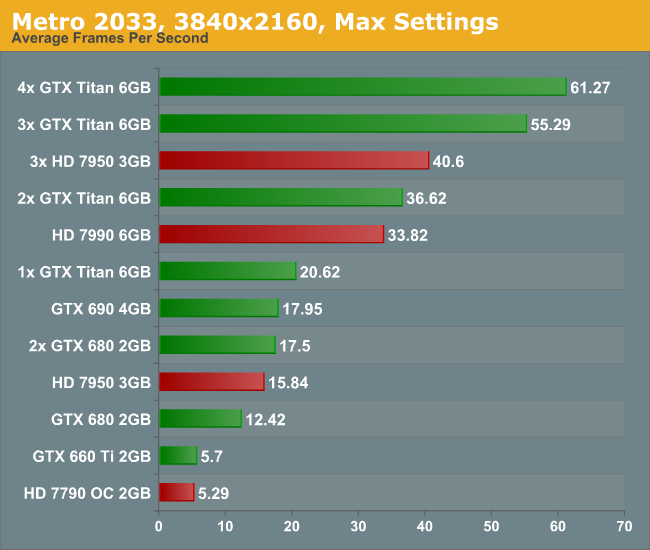
Straight off the bat is a bit of a shocker – to get 60 FPS we need FOUR Titans. Three 7950s performed at 40 FPS, though there was plenty of microstutter visible during the run. For both the low end cards, the 7790 and 660 Ti, the full quality textures did not seem to load properly.
Dirt 3, Max Settings, 3840x2160:
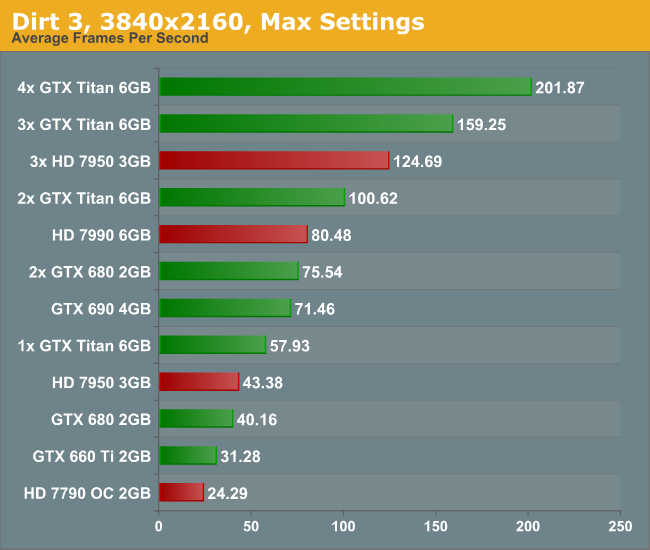
Dirt is a title that loves MHz and GPU power, and due to the engine is quite happy to run around 60 FPS on a single Titan. Understandably this means that for almost every other card you need at least two GPUs to hit this number, more so if you have the opportunity to run 4K in 3D.
Sleeping Dogs, Max Settings, 3840x2160:
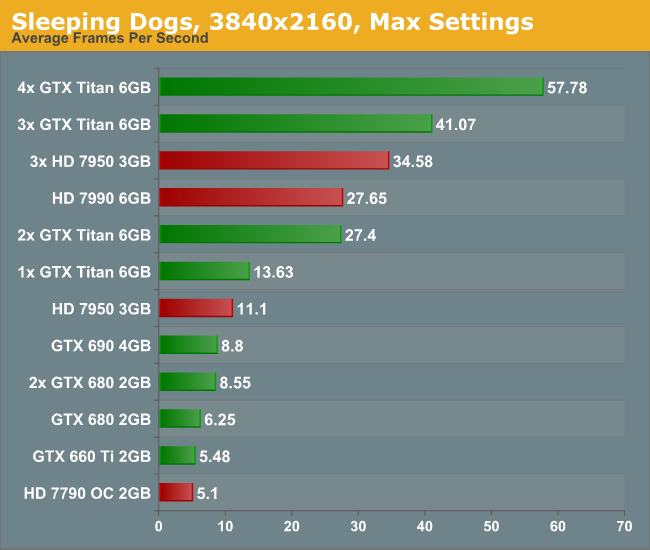
Similarly to Metro, Sleeping Dogs (with full SSAA) can bring graphics cards down to their knees. Interestingly during the benchmark some of the scenes that ran well were counterbalanced by the indoor manor scene which could run slower than 2 FPS on the more mid-range cards. In order to feel a full 60 FPS average with max SSAA, we are looking at a quad-SLI setup with GTX Titans.
Conclusion:
First of all, the minute you experience 4K with appropriate content it is worth a long double take. With a native 4K screen and a decent frame rate, it looks stunning. Although you have to sit further back to take it all in, it is fun to get up close and see just how good the image can be. The only downside with my testing (apart from some of the low frame rates) is when the realisation that you are at 30 Hz kicks in. The visual tearing of Dirt3 during high speed parts was hard to miss.
But the newer the game, and the more elaborate you wish to be with the advanced settings, then 4K is going to require horsepower and plenty of it. Once 4K monitors hit a nice price point for 60 Hz panels (sub $1500), the gamers that like to splash out on their graphics cards will start jumping on the 4K screens. I mention 60 Hz because the 30 Hz panel we were able to test on looked fairly poor in the high FPS Dirt3 scenarios, with clear tearing on the ground as the car raced through the scene. Currently users in North America can get the Seiki 50” 4K30 monitor for around $1500, and they recently announced a 39” 4K30 monitor for around $700. ASUS are releasing their 4K60 31.5” monitor later this year for around $3800 which might bring about the start of the resolution revolution, at least for the high-end prosumer space.
All I want to predict at this point is that driving screen resolutions up will have to cause a sharp increase in graphics card performance, as well as multi-card driver compatibility. No matter the resolution, enthusiasts will want to run their games with all the eye candy, even if it takes three or four GTX Titans to get there. For the rest of us right now on our one or two mid-to-high end GPUs, we might have to wait 2-3 years for the prices of the monitors to come down and the power of mid-range GPUs to go up. These are exciting times, and we have not even touched what might happen in multiplayer. The next question is the console placement – gaming at 4K would be severely restrictive when using the equivalent of a single 7850 on a Jaguar core, even if it does have a high memory bandwidth. Roll on Playstation 5 and Xbox Two (Four?), when 4K TVs in the home might actually be a thing by 2023.
16:9 4K Comparison image from Wikipedia


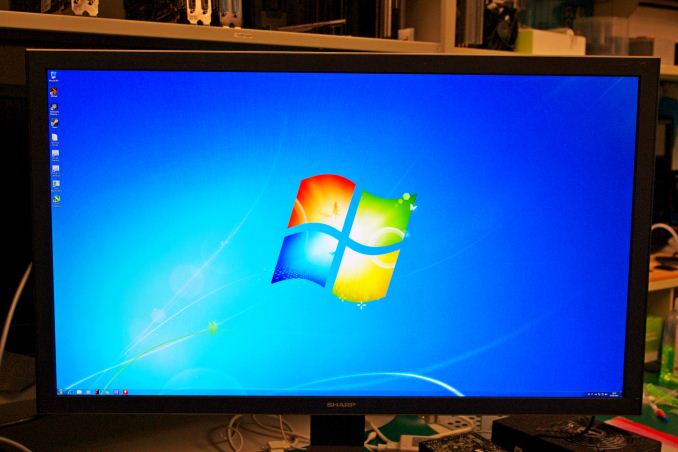

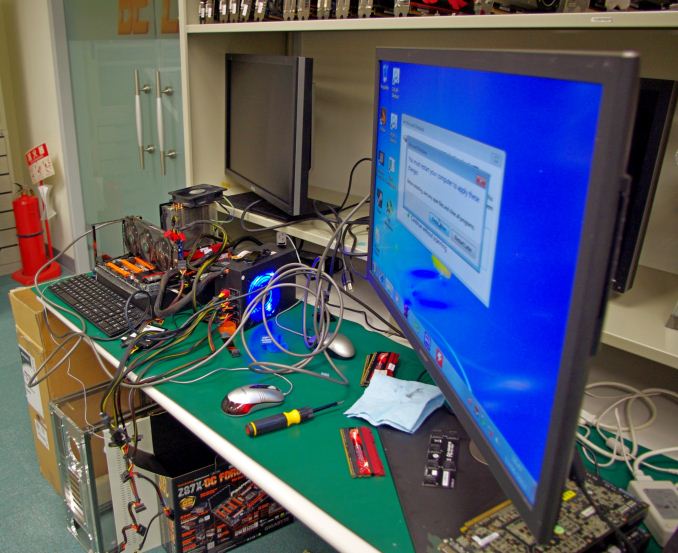

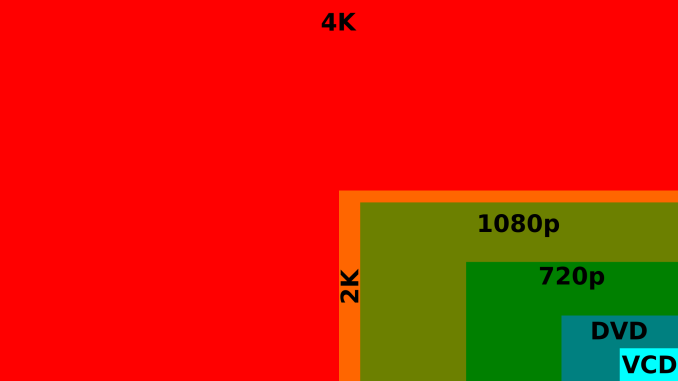








134 Comments
View All Comments
mapesdhs - Tuesday, July 2, 2013 - link
Ian, just a thought, did you use the default SLI mode when testing 3/4-way Titan?
When testing 2/3-way 580s, I found the default was in some cases nowhere near
as fast as selecting some other mode manually, eg. AFR2 boosted one of the
3DMark13 tests by 35% (though at the same time it dropped another by 10%).
Ian.
BMNify - Sunday, July 7, 2013 - link
"The good thing about GPUs is that 20nm is about to arrive,then the pseudo 16/14nm soon after and if they start to put the RAM on a silicon interposer they gain a lot of memory bw too."you don't really want an old silicon interposer for the next generations though, you Really Need the current and later "Wide IO(2)" with its generic 512bit bus as 4x128 configuration and Terabits/s throughput interconnect ,especially for the real 4K+/8K stuff in the pipeline now....
ask yourself this, how long is the real development timescale from one generation of CPU and GFX chip given the expected real 8K over the air retail devices by 2020ish...
that's only two GFX generations away, maybe 3 at best.... times running out if they don't already have acceptable throughput 8K + many audio channels (was it 128 channels or some such, i forget now) capable silicon in the lab right now
SetiroN - Monday, July 1, 2013 - link
No frame metering,doesn't matter.
MrSpadge - Monday, July 1, 2013 - link
Do you mean you'd prefer perfectly steady 10 fps over average 60 fps with dips down to 30 fps, i.e. very inconsistent? Otherwise.. the test does matter.chizow - Monday, July 1, 2013 - link
Interesting results, thanks for posting this. Would certainly like to see some of the blanks filled in with card configs and SLI/CF, as well as some settings with AA disabled.Either way, it does like we are in for a big spike in GPU requirements between higher resolutions, 3D and the next-gen consoles. Probably what Nvidia and AMD have been waiting for to spur sales.
tackle70 - Monday, July 1, 2013 - link
Good to know my two overclocked 780s are ready for this... I don't need AA at such high resolution, and I could always add a third 780 down the road. Now I just hope someone puts out a bare bones 4k panel with DisplayPort for $1K or soThis Guy - Monday, July 1, 2013 - link
Use 3x X-star or QNIX monitors with VESA stands, mount in portrait and bingo, 4320*2560 @ 100-135Hz for around 1k.If you want to minimise bezels remove the panel and electronics from the case and build a new wooden one for them. The bezel is about twice as thick as the metal edge around the panel so you can get them a fair bit closer.
tackle70 - Monday, July 1, 2013 - link
Yeah I know about those options but I am a one screen guy... Just cant stand bezels. I'm happy with my 1440p monitor until 4k 60 Hz comes aroundnakquada - Monday, July 1, 2013 - link
Metro 2033 is an awfully programmed game and I really don't know why it is used in benchmarks. The developers admitted themselves that the engine is horribly optimized. I'd like to see something like Battlefield 3 or Tomb Raider or Skyrim + Mods.IanCutress - Monday, July 1, 2013 - link
Games that have separate interfaces to run benchmarks are a godsend to testers. Normally while I have a benchmark running I can continue writing another article or set up the next test system / install an OS. Metro2033 does this better than most, and is a strenuous enough benchmark.Despite this, a lot of games and engines are not optimized. Plus it doesn't really matter if the engine is optimised for benchmarks - users who play the game are going to experience the same results as we do with the same settings. So an argument that 'this benchmark is not optimised' is quite a large non-sequitur in the grand scheme of things - the games are what they are and it's not for reviewers to optimise them. If I had had more time and preparation, I would have perhaps included Tomb Raider / Bioshock Infinite in there as well.